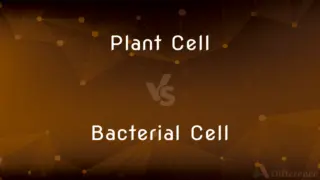Sulfite vs. Sulfur Trioxide — What's the Difference?
By Tayyaba Rehman — Published on November 22, 2023
Sulfite is a compound containing a sulfur atom bonded to three oxygen atoms with a 2- charge, often used as a food preservative. Sulfur trioxide is a compound of one sulfur atom and three oxygen atoms, crucial in sulfuric acid production.

Difference Between Sulfite and Sulfur Trioxide
Table of Contents
ADVERTISEMENT
Key Differences
Sulfite is known for its role as a preservative in various food and beverage items, particularly in maintaining the freshness and preventing the oxidation of products. On the other side, Sulfur trioxide is not utilized as a preservative and is notably prominent in the chemical industry, especially in the production of sulfuric acid, due to its ability to combine with water to form this acid.
The chemical formula of a sulfite ion is SO3^2-, indicating a sulfur atom surrounded by three oxygen atoms and carrying a negative charge of 2. Contrarily, Sulfur trioxide comes with the chemical formula SO3, presenting a molecular composition where a sulfur atom is bonded with three oxygen atoms, without bearing an additional charge as sulfite does.
In the realm of application, sulfites find usage in a variety of industries, such as the wine industry, where they are utilized to inhibit microbial growth and oxidation, keeping the product fresh and preserving its flavors. Sulfur trioxide, however, is not directly applied in food industries but plays a pivotal role in creating sulfuric acid, which subsequently finds varied industrial applications.
When considering health implications, sulfites can induce allergic reactions in some individuals, manifesting in symptoms like headaches, hives, and respiratory issues. In contrast, Sulfur trioxide does not typically induce allergic reactions but can pose significant health risks due to its highly corrosive and reactive nature, causing respiratory irritation and damage to materials it comes into contact with.
Environmental aspects of sulfites involve their potential to create sulfur dioxide when burned, contributing to air pollution. Comparatively, Sulfur trioxide, when released into the environment, can combine with atmospheric water vapor, creating sulfuric acid rain, posing detrimental effects on ecosystems and built environments alike.
ADVERTISEMENT
Comparison Chart
Charge
Carries a 2- charge
Does not carry a charge
Use in Industry
Widely used as a preservative
Used to produce sulfuric acid
Chemical Formula
SO3^2-
SO3
Health Implications
Can cause allergic reactions
Highly corrosive and irritating
Environmental Impact
Produces sulfur dioxide when burned
Can form acid rain
Compare with Definitions
Sulfite
A salt or ester of sulfurous acid.
Sulfites are commonly utilized in the wine industry to prevent oxidation.
Sulfur Trioxide
A chemical compound with the formula SO3.
Sulfur trioxide reacts with water to form sulfuric acid.
Sulfite
Used as a food preservative.
Sulfites are added to dried fruits to preserve their color and freshness.
Sulfur Trioxide
Utilized in the production of sulfuric acid.
The contact process for sulfuric acid production involves the oxidation of sulfur dioxide to sulfur trioxide.
Sulfite
Can cause allergic reactions.
Some people experience headaches after consuming foods preserved with sulfites.
Sulfur Trioxide
A highly reactive and corrosive substance.
Sulfur trioxide can cause burns upon contact with the skin.
Sulfite
Contains the anion SO3^2-.
The sulfite ion has three oxygen atoms bonded to a central sulfur atom.
Sulfur Trioxide
A dense, white, hygroscopic compound.
Sulfur trioxide will form corrosive sulfuric acid upon coming into contact with atmospheric moisture.
Sulfite
Inhibits microbial growth.
Sulfites in wine help to prevent the growth of unwanted bacteria and yeast.
Sulfur Trioxide
Can form acid rain when combined with water in the atmosphere.
The release of sulfur trioxide into the atmosphere is environmentally concerning due to its role in creating acid rain.
Sulfite
The divalent anionic group SO3, derived from sulfurous acid, or a compound containing this group.
Sulfite
Any salt of sulfurous acid.
Common Curiosities
Can sulfite cause allergic reactions?
Yes, sulfites can trigger allergic reactions in some individuals.
How is sulfur trioxide related to sulfuric acid?
Sulfur trioxide reacts with water to produce sulfuric acid.
Is sulfur trioxide dangerous to handle?
Yes, sulfur trioxide is corrosive and can cause burns.
What is the physical appearance of sulfur trioxide?
Sulfur trioxide is typically a white, hygroscopic solid.
What is sulfite commonly used for?
Sulfite is commonly used as a preservative in foods and beverages.
Can sulfite be found naturally in foods?
Yes, sulfites can naturally occur in some foods like grapes.
Are sulfites found in all wines?
Sulfites are present in most wines but may be absent in some organic or biodynamic ones.
Is it safe to consume sulfite?
Sulfite is safe for most people but can cause reactions in sulfite-sensitive individuals.
How is sulfur trioxide produced industrially?
Sulfur trioxide is commonly produced via the contact process in industry.
Can sulfur trioxide form acid rain?
Yes, sulfur trioxide can react with water vapor in the atmosphere to create acid rain.
In what state is sulfur trioxide at room temperature?
Sulfur trioxide is typically a solid at room temperature.
Are sulfites only used in the food industry?
While common in the food industry, sulfites are also used in pharmaceuticals and other industries.
Why is sulfite added to dried fruits?
Sulfite is added to prevent oxidation and maintain color in dried fruits.
Share Your Discovery

Previous Comparison
Iron Sulfate vs. Iron Gluconate
Next Comparison
Plant Cell vs. Bacterial CellAuthor Spotlight
Written by
Tayyaba RehmanTayyaba Rehman is a distinguished writer, currently serving as a primary contributor to askdifference.com. As a researcher in semantics and etymology, Tayyaba's passion for the complexity of languages and their distinctions has found a perfect home on the platform. Tayyaba delves into the intricacies of language, distinguishing between commonly confused words and phrases, thereby providing clarity for readers worldwide.
















































